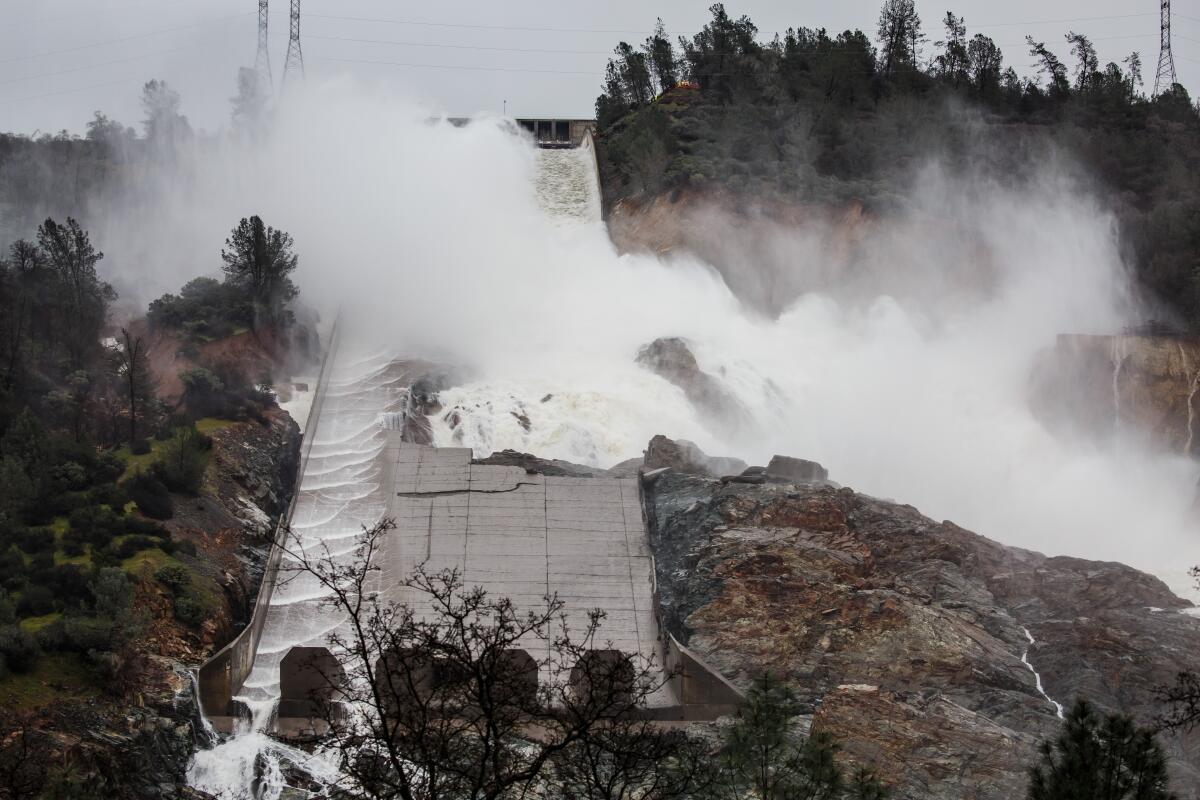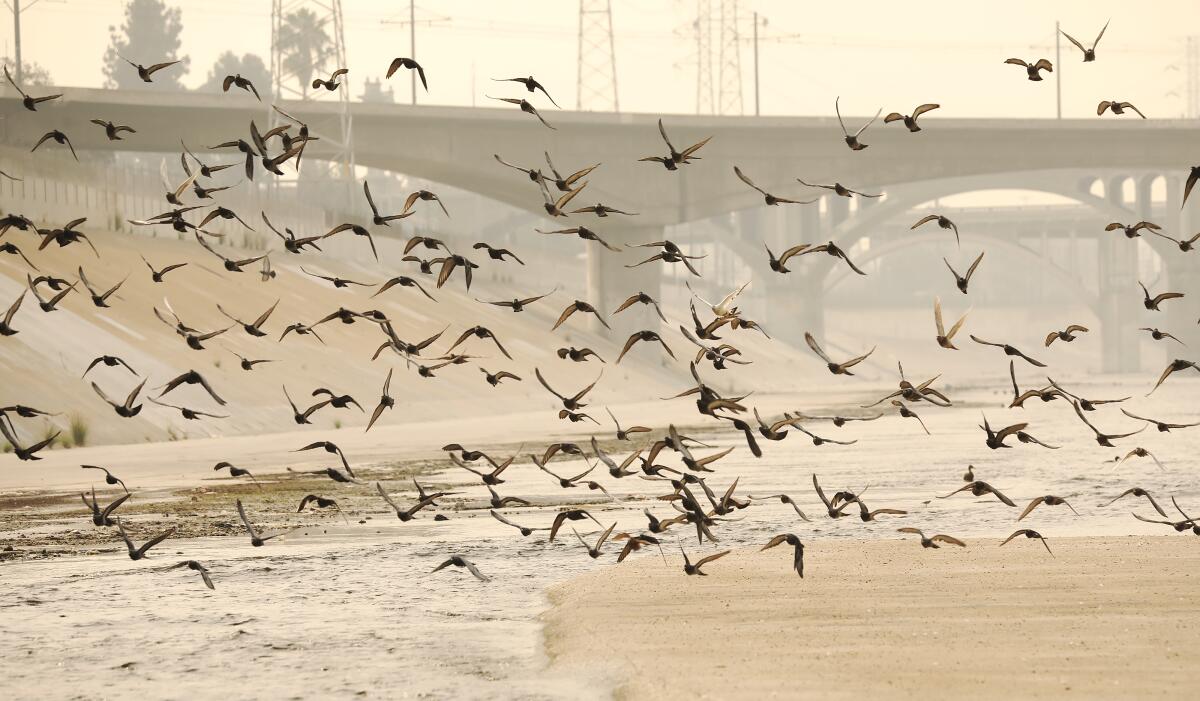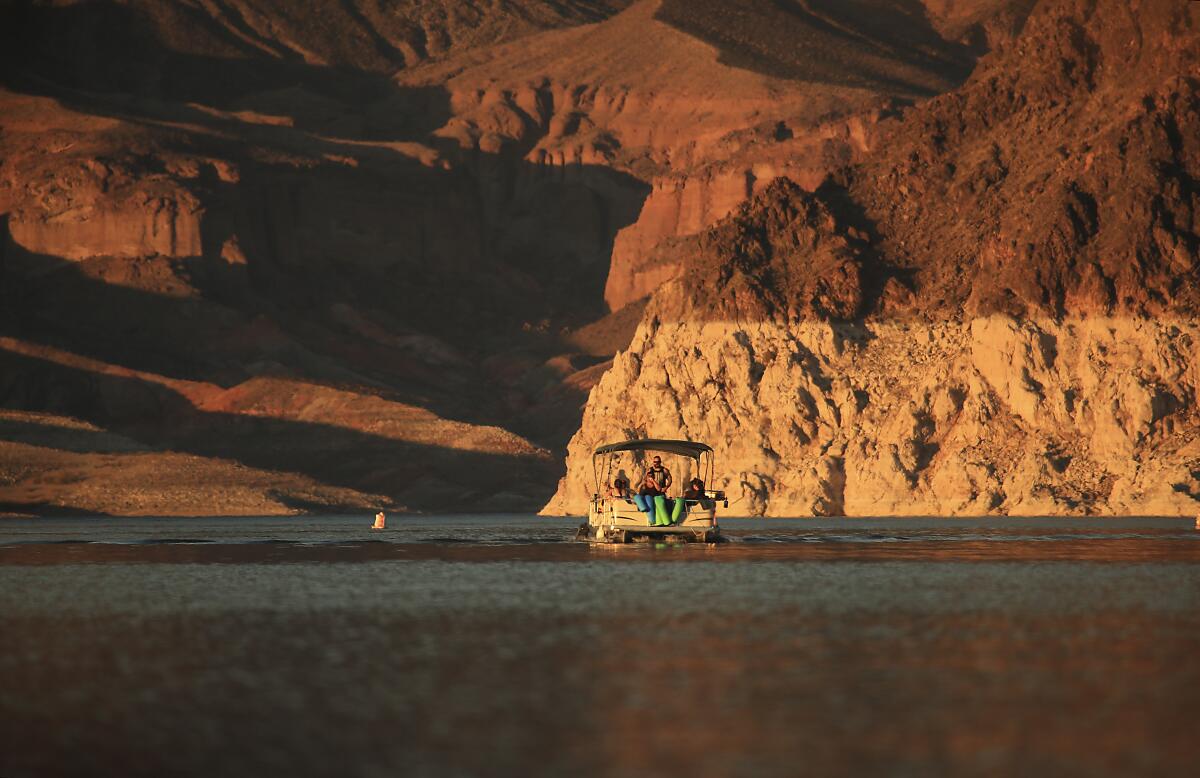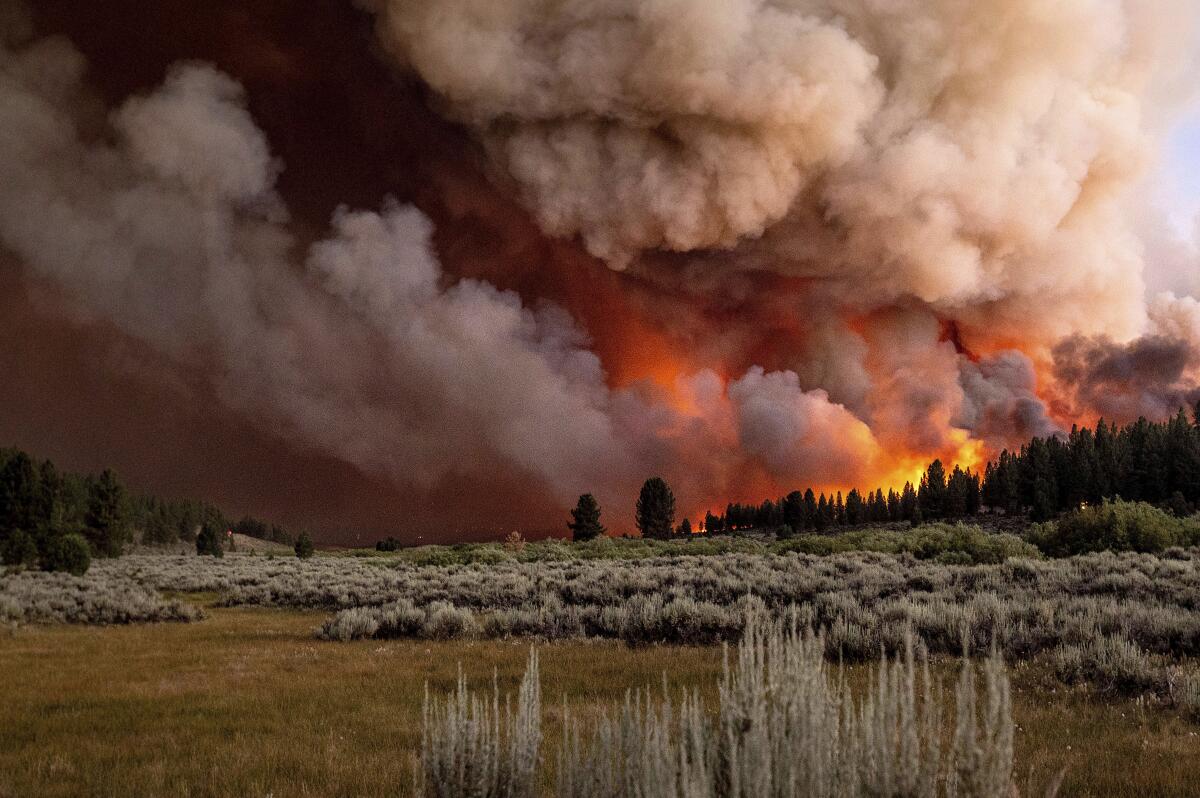Newsletter: Why California should be preparing for floods, even in the midst of drought
- Share via
This is the July 15, 2021, edition of Boiling Point, a weekly newsletter about climate change and the environment in California and the American West. Sign up here to get it in your inbox.
Good morning. I’m Stuart Leavenworth, editor of Boiling Point, and I’m filling in for Sammy Roth, who is taking some well-deserved time off. He’ll be back next week.
The explorer John Wesley Powell once poked fun at the professional rainmakers of his time, writing, “Years of drought and famine come and years of flood and famine come, and the climate is not changed with dance, libation or prayer.”
As we now know, humans can change the climate — one reason the current drought is so intense, sparking what could be a record wildfire season and depleting mighty reservoirs such as Mead and Oroville.
Yet as Powell noted, the West can quickly swing from drought to flood. And it will again — possibly with greater ferocity than before. Atmospheric modeling is showing that, like our current drought, future floods will be bigger and more intense, said Jeffrey Mount, a geologist and water expert with the Public Policy Institute of California.
That is pretty scary. California already has a storied history of floods, including the Christmas 1861 inundation that transformed the Central Valley into a giant lake, and more recent deadly floods in 1955, 1986 and 1997. Now, as Mount told me last week:
“Our ‘wets’ are getting wetter, and our ‘dries’ are getting drier.”
“So the very thing we are grappling with — unusually dry conditions — will translate to unusually wet conditions at some point,” he added. “It could be next year, it could be the year after, it could be five years from now.”
A former professor at UC Davis, Mount is author of an essential water book, “California Rivers and Streams.” This 1995 book previewed much of the climate change our state now confronts, while chronicling human follies in trying to control nature, such as the concrete straitjackets that shackle Los Angeles’ rivers. (Sammy wrote about these in April.)
I talked with Mount about why California should try to take advantage of these dry years to prepare for later “wets,” and why our collective preparation seems so spotty. Our exchange has been edited for clarity and brevity.
ME: So, Jeff, California has been pretty parched for two decades — with the exception of 2017. Is there any evidence that our big, scary flood years are becoming less frequent?
MOUNT: To be perfectly clear, there is zero evidence we are getting less flood prone, and abundant evidence we are becoming more flood threatened. We generally get a whopping big flood every decade in California. In fact, it is funny how everyone has forgot what happened in 2017 with Oroville Dam, where you had one of the largest evacuations in the history of California.

ME: What is changing?
MOUNT: The problem we face is warming. While it dries us out — the atmosphere gets more thirsty because it is warmer — it also means the atmosphere can “hold” more water. This is what we are seeing more and more. As these storms come into the West Coast, they are richer in water, including our No. 1 flood generator, atmospheric rivers — these narrow bands of highly concentrated moisture.
So in every year on the West Coast, it is the Clint Eastwood philosophy: “Do you feel lucky, punk?”
ME: I am not feeling lucky. You make an important point, that California should be using these dry decades to better guard itself for the years ahead. Have we done that?
MOUNT: I know you will hate this. There is a reason scientists have two hands and a “but” — so we can say, on the one hand, but on the other hand.
The answer is — it depends. The 2007 flood reform legislation for the Central Valley has really resulted in major reductions of flood risk, particularly in areas such as Sacramento.
But the fundamental flaw with that 2007 law is it focused just on the Central Valley, instead of encouraging statewide upgrades in flood risk reduction. Remember, one out of five Californians are at risk of flooding, and they are not all in the Central Valley.
ME: So what other parts of the state should we be worried about?
MOUNT: You might want to flip it on its head. What parts of the state should we NOT be worried about?
To be clear, the Central Valley will always be the area that will give us the most concern, partly because of its vast size. When you count the neighboring mountains, 40% of the surface area of California drains through the Central Valley and out to the Carquinez Strait. It is a bathtub, with 6,000 miles of levees. So of course we will remain concerned about that.
But here are the two areas that make me nervous. One is the south coast — Los Angeles and the rest of Southern California.
I can’t think of a creek or river in the south coast that doesn’t have some high level of risk. With the shift toward more intense precipitation events, the risk is increasing substantially.
ME: But the method of flood control hasn’t changed much, right?
MOUNT: We are dealing with almost a 100-year-old legacy decision in California, which was to channelize rivers. We made the near-term economic decision, starting in the 1930s, to put houses as close as possible to our waterways and then straighten and line them with concrete. Science has shown that is a failed approach, the reason being — it is eventually going to bite you.

The second place is the Bay Area. There, they get it. They have a combination of flashy creeks that come into an estuary, and rising sea levels along a shoreline where you have millions of dollars of properties. They also have this same problem with 1930s infrastructure — basically taking creeks and turning them into these rectangular, concrete-lined canals and hoping for the best.
ME: Let’s talk a bit about the interplay of natural forces, climate-influenced threats and aging infrastructure. Amid this drought, Santa Clara County has had to draw down a key water reservoir because of quake risk to the reservoir’s dam.
MOUNT: Well, California, as you know, is the primordial origin of natural catastrophes — we have earthquakes, floods, fires, mudslides and all of this comes together in a nexus of disasters.
But this nexus only matters if you are not prepared. We only need to look at Oroville as an oh-oh warning. We have hundreds of high-hazard dams in California. Most are in pretty good shape, but many of them were built 70 and 80 years ago and were designed for a different hydrology.
Seismic risk is an existential threat to water supply. Along the San Andreas fault in Southern California, major movements of the fault can knock out water supply there in a bunch of places.
And it is not just earthquake risk. Places such as the Placer County Water Agency are tearing their hair out over impact of intense fires. They’ve caused damage to headwater forests, which in turn damages the water supply.
ME: Your 1995 book holds up pretty well in describing climate change’s potential impact to California. If you could rework those sections, knowing what you know now, what would you revise?
MOUNT: Back then, I hadn’t really appreciated how much more intense droughts would become. We didn’t really understand this concept of evaporative demand — the thirst of the atmosphere and how it played a role in drying out the landscape.
This drying out is a big deal. It’s going to put huge pressure on our water systems. At the same time, the modeling is consistent — we will see fatter atmospheric rivers in the future.
On that bright note, here’s what else is happening around the West:
TOP STORIES

Next month, the federal government expects to declare its first-ever shortage on Lake Mead, the water lifeline for much of the West. That declaration will trigger cuts of Colorado River water to Arizona, Nevada and Mexico by year’s end. If the lake drops 28 more feet by next year, California will see its spigot start to tighten in 2023, my colleagues Jaweed Kaleem and Tom Curwen report, with eye-opening photographs by Allen J. Schaben. What can Southern California do? Julia Wick and Chris Kuo talk to experts on further water conservation opportunities.
“Within a few minutes, the second line went. And then a few minutes later, the third line went.” That’s what the chief operating officer of the California Independent System Operator told Sammy Roth in this riveting reconstruction about how an Oregon wildfire zapped power lines and nearly toppled California’s power grid. Sammy’s story illustrates the “disaster nexus” that Jeffrey Mount describes above, in this case, fires and climate change complicating a longstanding California problem — dependable energy.
Illegal marijuana farming is flowering in an unlikely spot — the California desert — and is bringing with it death and environmental destruction, as Jaclyn Cosgrove and Louis Sahagun report for The Times. You might think this is a problem the drought might solve. But there are big bucks to be made with illegal pot farms, and as the saying goes, “Water flows uphill towards money.”
FIRES AND EXTREME HEAT

Hardly a news flash, but this California fire season is off to a horrible start. More than twice as many acres have burned in the first six months of 2021 than last year in the same period, The Times’ Hayley Smith reports. Hayley notes separately how dry the landscape is this year. That’s led to one of the biggest blazes, the Beckwourth Complex fire, which more than doubled in size Friday to Saturday in the Plumas National Forest, as colleague Alex Wigglesworth detailed. Meanwhile, the state’s total cost for emergency fire suppression is likely to surpass $1 billion for the first time, in the most recent fiscal year, as Yoohyun Jung reports for the San Francisco Chronicle.
Record heat is fueling the fires, while causing its own separate misery. Death Valley on Sunday recorded the highest 24-hour average temperature ever recorded on the planet — 118.1 degrees — as Jason Samenow reports for the Washington Post. Other records fell in Palmdale and other desert communities near L.A., as James Rainey and Alex Wigglesworth note. Such heat can be perilous for anyone unprotected or outdoors, including homeless people. The Times’ Madalyn Amato shares these tips for protecting unhoused people.
Record heat. Raging fires. What are the solutions?
Get Boiling Point, our newsletter about climate change, the environment and building a more sustainable California.
You may occasionally receive promotional content from the Los Angeles Times.
Those wanting to cool off at some L.A.-area beaches might want to wait. A mishap at the Hyperion sewage treatment plant in Playa del Rey caused 17 million gallons of sewage to spew into the ocean on Sunday, as The Times’ Leila Miller reported. My colleagues Robert J. Lopez and Chris Kuo explore the questions abounding on why it took L.A. County officials so long to alert the public.
THE ENERGY TRANSITION
Remember when President Biden campaigned on ending new oil and gas drilling on federal lands? U.S. approvals for new drilling are on pace this year to reach their highest level since George W. Bush was president, the Associated Press’ Matthew Brown reveals in this stunning report. Here in California, Gov. Gavin Newsom’s oil regulators gave hope to keep-it-in-the-ground advocates by rejecting 21 new drilling permits.
The debate continues on the quickest way to transition to cleaner energy — go big, or go broad? Sammy Roth has written about the tradeoffs of building big solar farms and transmission lines versus emphasizing rooftop solar and more local power grids. The New York Times has an impressive multimedia look at this national debate, courtesy of Ivan Penn, Clifford Krauss and Tamir Kalifa.
ONE MORE THING

If you need a break from climate doom-scrolling — and believe me, I sure do — spend some time with Liset Garcia. This San Joaquin Valley farmer and fruit-stand operator was the focus of a touching Times story this week by Diana Marcum, with exquisite photos by Brian van der Brug.
Garcia knows that climate change is drying up her water wells, and threatens her crops. But she channels her energy into all that is wondrous about life, including the people she meets and the flowers that still manage to bloom.
“Those poor sunflowers,” Garcia says at one point in the story. “I want to be resilient like them.”
We’ll be back in your inbox next week. If you enjoyed this newsletter, please consider forwarding it to your friends and colleagues.




